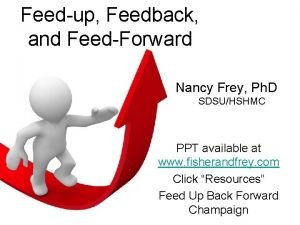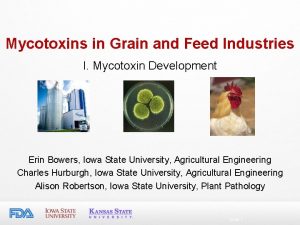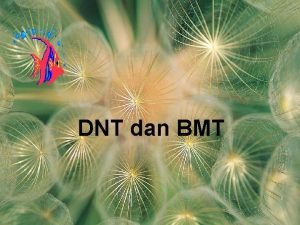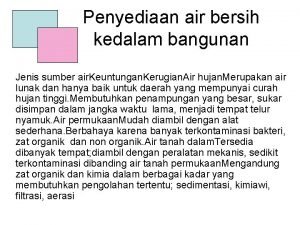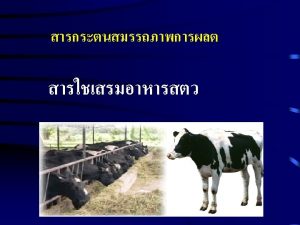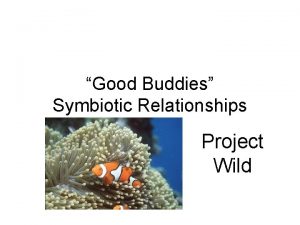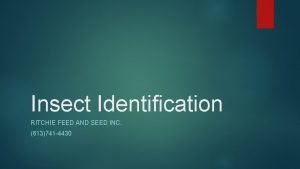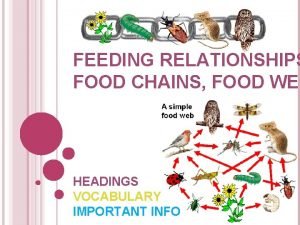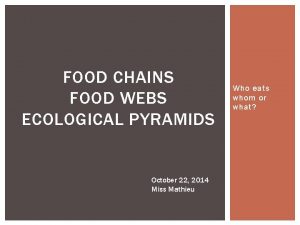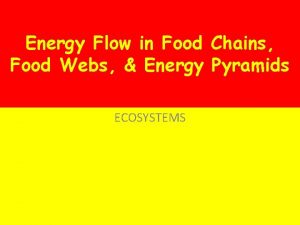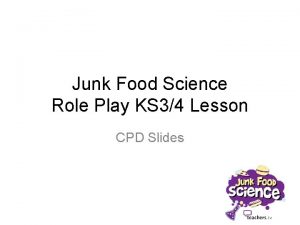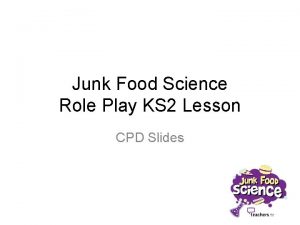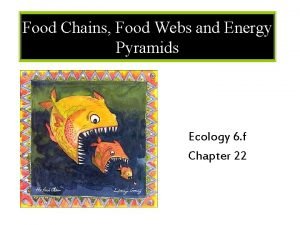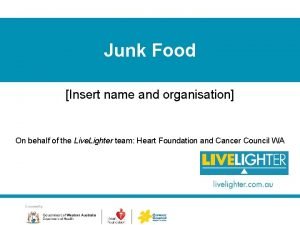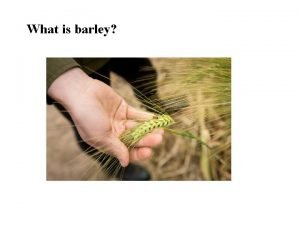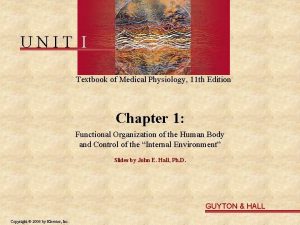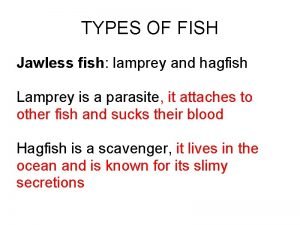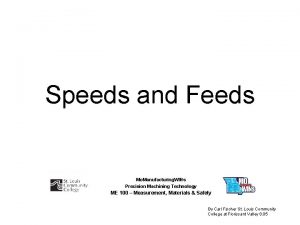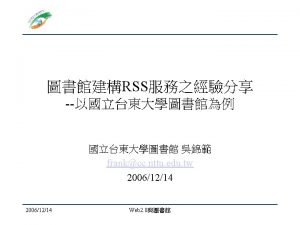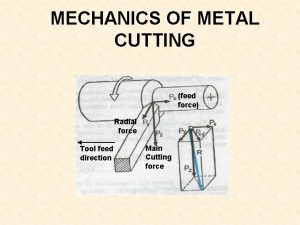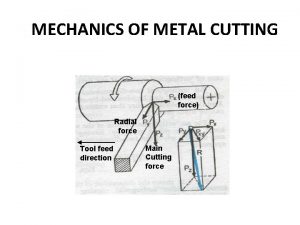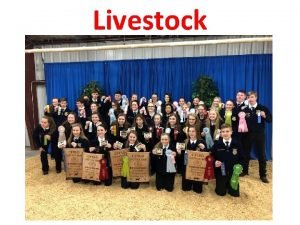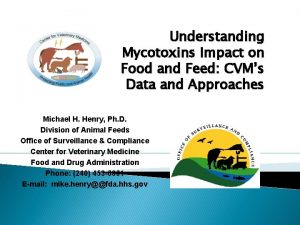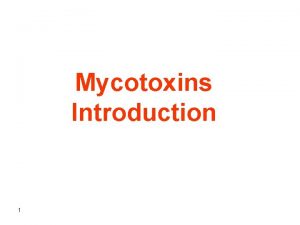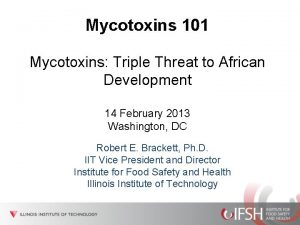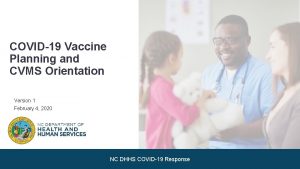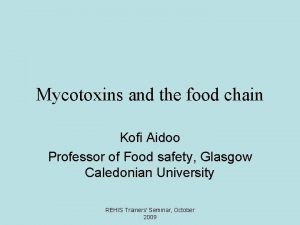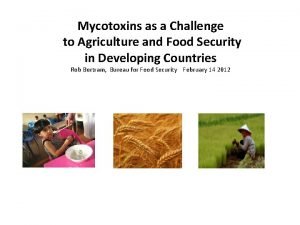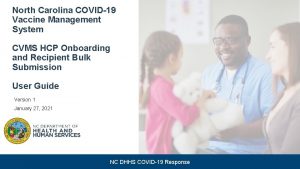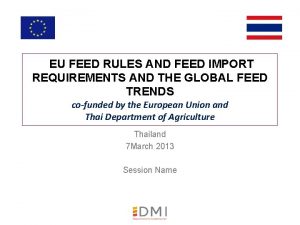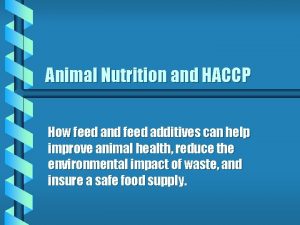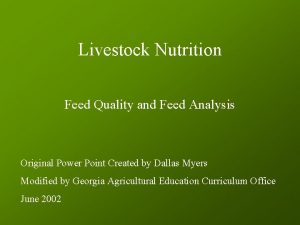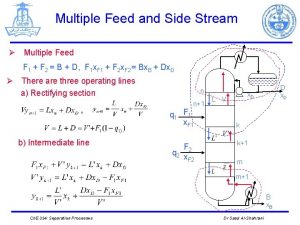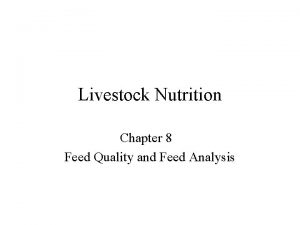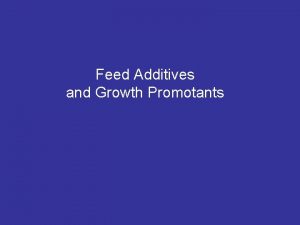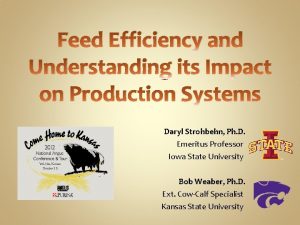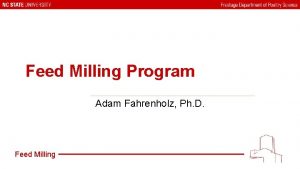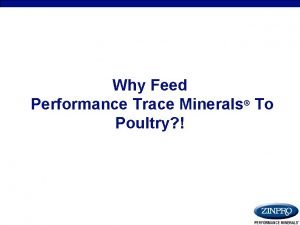Understanding Mycotoxins Impact on Food and Feed CVMs







































- Slides: 39

Understanding Mycotoxins Impact on Food and Feed: CVM’s Data and Approaches Michael H. Henry, Ph. D. Division of Animal Feeds Office of Surveillance & Compliance Center for Veterinary Medicine Food and Drug Administration Phone: (240) 453 -6861 E-mail: mike. henry@@fda. hhs. gov

Introduction Ø CVM and Regulations Ø Mycotoxins § Aflatoxins, Fumonisins, Vomitoxin (DON), Ochratoxins, and Zearalenone �Occurrence �Health Effects Ø Mycotoxin Data Ø Summary Surveillance Program and

CVM and Regulations Ø CVM and Responsibilities § The Center for Veterinary Medicine (CVM) is a consumer protection organization. We foster public and animal health by approving safe and effective products for animals and by enforcing other applicable provisions of the Federal Food, Drug, and Cosmetic Act and other authorities. § Within CVM, the Division of Animal Feeds is responsible for ensuring that food for companion animals and feed for food-producing animals are safe and wholesome. § The feed industry plays a critical role in the production of safe wholesome meat, milk, fish, and eggs ($50 -100 Billion).

CVM and Regulations CVM Authority Ø Federal Food, Drug, and Cosmetic Act § SEC. 402. [21 U. S. C. 342] A food shall be deemed to be adulterated • (a)(1) If it bears or contains any poisonous or deleterious substance which may render it injurious to health; … § SEC. 406. [21 U. S. C. 346] TOLERANCES FOR POISONOUS INGREDIENTS IN FOOD • When any poisonous or deleterious substance cannot be avoided by good manufacturing practice, the Secretary shall promulgate regulations limiting the quantity therein or thereon to such extent as he finds necessary for the protection of public health

CVM and Regulations Regulatory Limits Ø Ø Ø Tolerances: represent limits above which the product is adulterated as a matter of law. FDA can take legal action to remove products from the market without having to prove them unsafe. Action Levels: represent limits at or above which FDA may take legal action to remove products from the market. Guidance or advisory levels are recommended maximum levels that FDA considers adequate to protect human and animal health.

Mycotoxins Ø Secondary metabolites of fungi (molds) Ø Organic chemicals (C, N, O, & H) Ø Ø There are more than 300 known mycotoxins Mycotoxins that have grabbed most attention worldwide: § Aflatoxins, ochratoxin A, and zearalenone § Trichothecenes and fumonisins, § Ergot alkaloids Ø Stable and persistent

Aflatoxins Ø Produced by Aspergillus sp. § A. flavus and A. parasiticus) Ø Common feed substrates: § Corn, cottonseed, peanuts, and sorghum. Ø Four major aflatoxins in feed: B 1, B 2, G 1 & G 2 Ø M 1 in milk of humans and animals Ø High levels of aflatoxins associated with: § above-average temperature § below-average rainfall

Aflatoxins In Animals and Humans: Ø Major target organs § Liver and kidneys Ø Young adults animals more susceptible than Ø Monogastric animals more susceptible than ruminants Ø Acute aflatoxicosis can be fatal

Aflatoxins In Animals and Humans: Ø Carcinogenicity § Liver cancer is a serious consequence of longterm exposure to aflatoxins. § Hepatitis B infection may exacerbate the effects of aflatoxin exposure Ø Ø Decreased immune and reproductive function. Fetus/young chronically exposed may experience growth failure.

Aflatoxins Ø Action levels § Establish for Dairy cattle based on M 1 in milk • 20 ppb in feed and feed ingredients § In other classes of animals • Safety of animals and residues in tissues § Available Literature • 1960 to 1987

Fumonisins Ø Produced by Fusarium sp. (F. verticillioides) Ø Found worldwide § mainly in corn and particularly corn screenings Ø High levels associated with: § hot and dry weather § followed by periods of high humidity Ø Three major fumonisins in feed § B 1, B 2 & B 3 = total fumonisins

Fumonisins Ø Target organs § Liver, brains, lungs Ø Suspected Ø Associated humans Ø carcinogens with Esophageal cancer in Most susceptible species § Equine, Swine, § Dogs and Cats

Fumonisins Ø Equine: § Leukoencephalomalacia (ELEM) Ø Swine: § Liver damage, pulmonary edema Ø Cattle and Sheep: § Mild liver damage, moderate feed refusal Ø Poultry § Reduce growth, mild liver damage Ø Guidance levels: § based on animal safety

Vomitoxin (DON) Ø Ø Produced by members of genus Fusarium (especially F. graminearum) Commonly found on wheat, barley, rye, and oats Reported most frequently in cool, temperate regions (northern U. S. and Canada) Member of the trichothecene family of mycotoxins (include T-2 and HT-2 toxins)

Vomitoxin (DON) Ø Target organs § Liver, brains, lungs, and immune system § Vaccine failures Ø Most susceptible species § Swine, dogs, and cats Ø In Humans § Associated with alimentary toxic aleukia (ATA) § Gastrointestinal issues Ø Advisory levels: - based on safety of animals

Zearalenone Ø Ø Produced by Fusarium sp. (primarily F. graminearum) Common substrates are corn, wheat, barley, and occasionally in oats Production favored by high humidity and low temperatures Most susceptible species § Swine, dogs, and cats

Zearalenone (ZEA) Ø Target organs • Binds to the estrogen receptor (ER) • Reproductive and immune system Ø In Humans ZEA is associated with: • Endometrial tumors • Precocious puberty • Male sterility Ø In Animals • Reduce reproductive performance

Ochratoxin A Ø Ø Produced by Penicillium sp. (P. viridicatum) and possible (Aspergillus ochraceus) Highest levels usually found in cereal grains (corn, barley, wheat and rye) Produced mainly under poor storage conditions At least nine ochratoxins identified § Ochratoxin A is the most common § Greatest toxicological significance

Ochratoxin A Ø Target organs § Renal, hepatic, and immune system § A suspected carcinogen Ø Effects in Animals § Swine: reduces growth rate and nephropathy § Poultry: poor weight gain, feed conversion, egg production, egg shell quality, and nephrotoxicity § Dogs and cats: anorexia, weight loss, vomiting, bloody diarrhea, and nephropathy

Ochratoxin A Ø Effects in Humans § Associated Endemic nephropathy • Kidney damage incidence • binding to plasma proteins § Found in breast milk • Source of exposure for infants

Mycotoxins are Potential Hazards to both Humans and Livestock

Mycotoxin Surveillance Program and Data Ø Feed Surveillance Program § Program - reliable mycotoxins data on feed commodities to address risk assessment and feed safety issues. § This includes planning and directing operational activities for the program § Collecting and summarizing program data for comprehensive written and oral reports § Managing program information databases § Coordinating sampling and testing procedures with participating federal laboratories

Mycotoxin Surveillance Program and Data CVM’s Mycotoxin Surveillance Program. § Aflatoxins in corn, corn and peanut products, and complete feed § Fumonisins in corn, corn products and feed § Vomitoxin (deoxynivalenol) barley, wheat and swine feed § Zearalenone in swine feed and pet food § Ochratoxin A in oats

Mycotoxin Surveillance Program and Data Ø Sampling: Must ensure that the mycotoxins in the analytical sample is truly representative of the consignment. ØA few kernels of corn with 100 ppm aflatoxins can result in 1 kg sample exceeding the 20 ppb action level (kernel is approximately 0. 25 grams). Ø Minimum collected of 10 subsamples should be

Mycotoxin Surveillance Program and Data Extraction and Analysis Ø Ø Ø Extraction and clean-up of the extract solutions (immunoaffinity columns, C 18, XAD) Analytical methods used are based on TLC, HPLC, ELISA, or Mass Spectrometry, ELISA ) Method must provide sensitive and selective results for a wide range of feed ingredients and animal feeds which are complex matrix.

Mycotoxin Surveillance Program Data (1994 to 2012) Mycotoxins # of Samples Positive samples Above guidance No % No. % of positive Aflatoxin 4757 623 13. 1 181 29. 0 Fumonisin 1184 652 55. 1 72 11. 0 Vomitoxin 475 234 49. 3 24 10. 3 Zearalenone 580 78 13. 4 71 100* Ochratoxin A 207 21 10. 1 19 100* * No established guidance levels

Mycotoxins in Corn Samples (1994 to 2012) Mycotoxins Aflatoxins (ppb) Fumonisins (ppm) Vomitoxin (DON) (ppm) Zearalenone (ppb) Ochratoxin A (ppb) #Samples Positive Min Max 2007 374 (18. 6) 0. 07 1067 941 532 (56. 5) 0. 1 53. 1 2 (15. 4) 0. 5 0. 6 26 (8. 7) 7. 4 463. 8 0 0 13 300 28

Aflatoxins in corn 1994 to 2012 40, 00 % Positive % <20 ppb 35, 00 30, 00 25, 00 20, 00 15, 00 10, 00 5, 00 19 94 19 9 19 5 9 19 6 9 19 7 9 19 8 99 20 0 0 20 1 0 20 2 0 20 3 0 20 4 05 20 0 20 6 0 20 7 0 20 8 0 20 9 10 20 1 12 0, 00

Aflatoxins in corn 1994 to 2012 Ø 1998: Crop contamination § Aflatoxin contamination of maize (corn) in the southeastern U. S. led to rejection rates of corn of up to 50%. § Aflatoxin contamination reached 1500 ppb Ø 2006 -2007: Crop contamination § Drought conditions and moisture stress led to aflatoxin on corn in Missouri/Kansas – rejection of harvested corn by buyers Ø 2011: Corn contamination: South/Midwest § Reduce feed availability and increase food and feed prices

Mycotoxins in Barley 1994 to 2012 Mycotoxins # of Samples Positive Samples Range Min Max 0 0 Aflatoxins (ppb) 107 0 0 Vomitoxin (DON) (ppm) 25 7 (28%) . 028 4. 43 Zearalenone (ppb) 4 2 (50%) 117 987 Ochratoxin A (ppb) 23 4 (17. 5%) 1. 2 15. 9

Mycotoxins in Wheat 1994 to 2012 Mycotoxins # of Samples Positive Samples Range Min Max 0 0 Aflatoxins (ppb) 107 0 0 Vomitoxin (DON) (ppm) 25 7 (28%) . 028 4. 43 Zearalenone (ppb) 4 2 (50%) 117 987 Ochratoxin A (ppb) 23 4 (17. 5%) 1. 2 15. 9

Mycotoxin Surveillance Program and Data Issues Ø Residues of mycotoxins concentrated in feed products obtained during human food and ethanol production § Vomitoxin in distiller's and brewer’s grains in 2011 (revised advisory levels) § Peanut meal form oil extraction Ø Ø Methods to analyze for mycotoxins in these co -products. Unpredictability of mycotoxin occurrences

Regulatory Approaches and Control Strategies Ø Use Existing Memorandum with USDA & FDA § Aflatoxin in peanuts and corn § Residues in meat, milk, and eggs Ø Establish cooperative agreements with States § Mycotoxins contaminated feeds § Aflatoxins in milk and milk products

Regulatory Approaches and Control Strategies Ø Feed Safety System § Above guidance levels for aflatoxins, fumonisins, and vomitoxin are reportable § Zearalenone at 250 ppb in swine feed –safety issue Ø Livestock and Pet Safety Reporting System § Consumers and pet owners can report adverse e vents

Regulatory Approaches and Control Strategies Recent Cases Ø Case #1 Aflatoxins in Dog Food, 2007 § Recalled due to elevated aflatoxin levels in corn § > 50 ppb in complete dog food cause death and injuries § Feed destroyed to prevent use in other species.

Regulatory Approaches and Control Strategies Recent Cases Ø Case #2 Aflatoxins in Peanuts, 2009 § 178, 561 lb of raw shelled peanuts containing 37 ppb aflatoxins § Used to produce oil for human consumption § Peanut meal not allowed to be used in dairy feeds

Summary Ø Ø Mycotoxins can be found in human food animal feed Mycotoxins are potential health hazards Residues in food can compromise immune system and affect drug effectiveness Prevention is the only effective and safe method to eliminate risk

Thank You

Acknowledgements Ø CVM Office of Surveillance and Compliance
 Feedback feed forward feed up
Feedback feed forward feed up Feed up feedback feedforward
Feed up feedback feedforward Mycotoxins in poultry
Mycotoxins in poultry Perbedaan feed additive dan feed supplement
Perbedaan feed additive dan feed supplement Sistem up feed
Sistem up feed Feed additive dan feed supplement
Feed additive dan feed supplement Safe feed safe food
Safe feed safe food Unit 2 food food food
Unit 2 food food food Eltonian pyramid
Eltonian pyramid Good buddies project wild activity
Good buddies project wild activity Ritchie feed and seed
Ritchie feed and seed Depth of cut formula for milling
Depth of cut formula for milling Ritchie feed and seed
Ritchie feed and seed Secondary consumer
Secondary consumer Third level consumer
Third level consumer How does the food chain go
How does the food chain go Food web
Food web Difference between food webs and food chains
Difference between food webs and food chains Food chains, food webs and ecological pyramids
Food chains, food webs and ecological pyramids Food chain and food web examples
Food chain and food web examples Food webs and energy pyramids answer key
Food webs and energy pyramids answer key Bill nye food chains
Bill nye food chains Role play on healthy food and junk food
Role play on healthy food and junk food Introduction of role play
Introduction of role play Skunk food chain
Skunk food chain Junk food examples
Junk food examples Introduction fast food
Introduction fast food 2row vs 6row feed barley
2row vs 6row feed barley Yahoo weather radar
Yahoo weather radar Feed-forward control physiology
Feed-forward control physiology Theory of metal cutting
Theory of metal cutting How do hagfish feed
How do hagfish feed Feed rate equation
Feed rate equation Rss feed 產生器
Rss feed 產生器 Examples of roughages
Examples of roughages Class
Class Locate the and place your spool of thread
Locate the and place your spool of thread Feed force in orthogonal cutting
Feed force in orthogonal cutting What is feed force
What is feed force Livengood feed tomball
Livengood feed tomball
